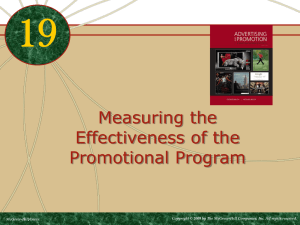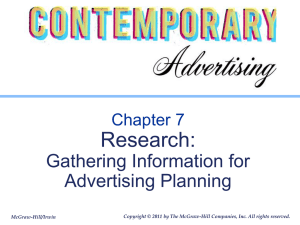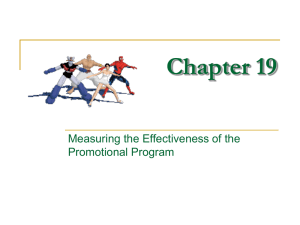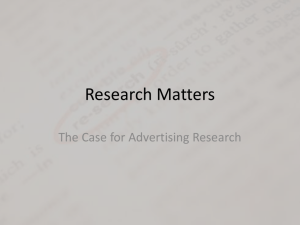Testing - McGraw Hill Higher Education
advertisement
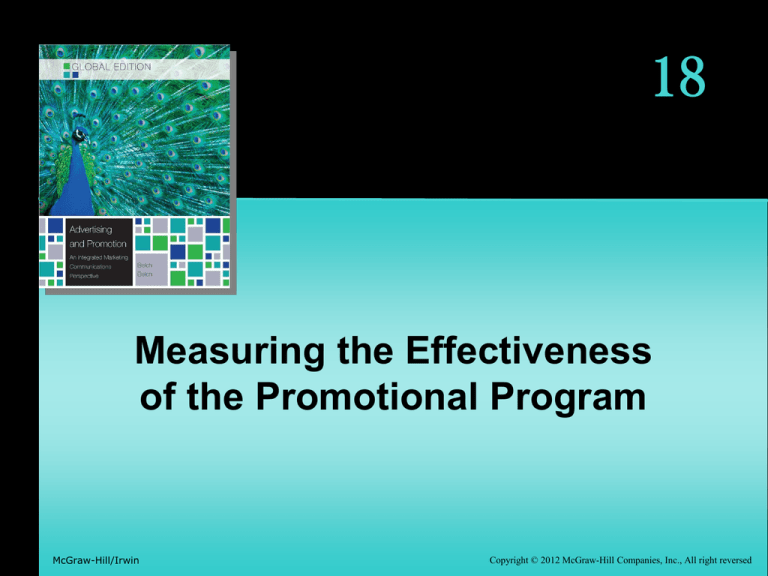
18 Measuring the Effectiveness of the Promotional Program McGraw-Hill/Irwin Copyright © 2012 McGraw-Hill Companies, Inc., All right reversed Reasons to Measure Effectiveness Advantages Disadvantages Avoid costly mistakes Cost of measurement Evaluate alternative strategies Research problems Increase efficiency in general Disagreement on what to test Determine if objectives are achieved Objections of creatives Time 18-2 Evaluating Alternative Strategies 18-3 Measuring Advertising Effectiveness What to test • • • • Source factors Message variables Media strategies Budget decisions How to test • Testing guidelines • Appropriate tests Where to test • Laboratory tests • Field tests When to test • Pretesting • Posttesting 18-4 Testing Methods 18-5 Where to Test In the Field In the Lab 18-6 Test Your Knowledge Laboratory methods of testing for advertisement effectiveness generally offer high control but low _____. A) realism B) external validity C) costs D) generalization E) value 18-7 Positioning Advertising Copy Test (PACT) 1. Provide measurements relevant to objectives of advertising 2. Require agreement on how results will be used 3. Provide multiple measures 4. Be based on a model of human response to communications 5. Consider multiple versus single exposure to the stimulus 6. Require alternative executions to have same degree of finish 7. Provide controls to avoid biasing effects of exposure context 8. Take into account basic considerations of sample definition 9. Demonstrate reliability and validity 18-8 Test Points 1.Concept Testing 2.Rough Testing Occurs at Various Stages 3.Finished art or commercial pretesting 4.Market testing (posttesting) 18-9 Concept Testing Objective Method Explores consumers’ responses to ad concepts expressed in words, pictures, or symbols Alternatives are exposed to consumers who match the target audience Reactions & evaluations sought through focus groups, direct questioning, surveys Sample sizes depend on the number of concepts and consensus of responses Output Qualitative and/or quantitative data evaluating and comparing alternative concepts 18-10 Focus Groups • Appeal • Results easily obtained, observable, immediate • Multiple issues can be examined • In-depth feedback is obtained • Drawbacks • • • • • • • Results not quantifiable Sample size too small Group influence may bias responses Some members may dominate discussion Participants become instant “experts” Members may not represent target market Results may be given too much weight 18-11 Rough Art, Copy, & Commercial Testing Comprehension and Reaction Tests Consumer Juries Advantages Disadvantages Control Consumer may become self-appointed expert Cost effectiveness Number of ads that can be evaluated is limited Endorsements by independent third parties A halo effect is possible Achievement of credibility Preference for ad types may overshadow objectivity 18-12 Rough Testing Terms Animatic Rough Terms Photomatic Rough Live-action Rough 18-13 Pretesting Finished Print Ads A laboratory method Portfolio Tests Includes test and control ads Portfolio test have problems Readability Tests Based on syllables per 100 words Dummy Advertising Vehicles Sent to random sample homes Other factors also considered Product interest may bias results 18-14 Test Your Knowledge _____ is a method of testing ads by placing them randomly in certain copies of regularly distributed magazines. A) Vehicle source testing B) Burke's reflection test C) A Flesch test D) Dummy advertising vehicle testing E) A contextual test 18-15 Pretesting Finished Broadcast Ads Physiological Measures Theater Tests On-Air Tests 18-16 Physiological Measures Pupil dilation Galvanic skin response Eye tracking Brain waves 18-17 Market Testing of Ads Inquiry Tests Recognition Tests Testing Tracking Studies Recall Tests 18-18 Starch Ad Recognition Scores Noting Score Brand-associated Score Read Most Score 18-19 Posttests of Broadcast Commercials Day after recall tests Tracking studies Persuasive measures Diagnostics Testing Comprehensive measures Single-source tracking Test marketing 18-20 Comprehensive Testing by Ipsos-ASI 18-21 Essentials of Effective Testing Establish communications objectives Use a consumer response model Use both pretests and posttests Use multiple measures Understand & implement proper research 18-22 Test Your Knowledge Good tests of advertising effectiveness must address the nine principles established by PACT, that we just reviewed on the previous slide. The first step in the model is to: A) Understand the appropriate research B) Create a model that uses multiple measures C) Establish communication objectives D) Decide whether to use posttests or pretests E) Develop a consumer response model 18-23 Measuring Effectiveness of Other Programs Sales promotions Shopping cart signage Nontraditional media Ski resort-based media In-store radio and television Other media Sponsorships Exposure methods Tracking measures 18-24
